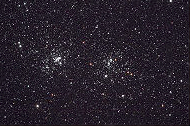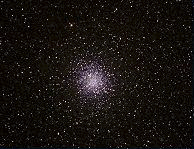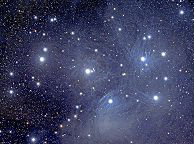Star Clusters
Gallery 1
|
Caldwell 14 |
This is a multi image stack all taken with my TMB-130 apo refractor, the modified Canon 6D and an IDAS LPS-V4 filter. Images were stacked and calibrated in Registax and processed in Photoshop CS6. Cumulative exposure was about 15 minutes at ISO 3200-6400. |
|
Messier 22 |
Here is one of M-22 that I took last summer with the C-14 HD at f/7 on a night of fairly good seeing. This is a stack of 3 x 3 minute exposures at ISO 1600 with the Canon 6D and IDAS LPS -V4 filter. In my opinion M-22 is a more impressive cluster than M-13, but we don't usually appreciate that because of its relatively low latitude and smack in the Milky Way. It is truly an awesome sight in the southern hemisphere where it appears directly overhead, but there of course it has even greater competition from Omega Centauri and 47 Tucanae. |
|
The Pleiades |
Thanks to the unusually long stretch of fine weather and fair seeing, I have had fun imaging from my observatory the past couple of months. |
Star Clusters
Star clusters are among the favorite deep sky objects for amateur telescopes. Many are listed in Charles Messier’s famed catalog and fall into two main types, open clusters and globular clusters.
Open clusters usually contain only a few hundred stars; some are often very young, having formed within a few hundred million years. M-45 the Pleiades is one of the best examples of this type of cluster. It’s easily visible to the naked eye and contains very hot and luminous stars. On the other hand, M-67, another prominent member of Messier’s catalog, is one of the oldest open clusters and estimated to be over 3 billion years old. Over time the stars in open clusters are likely to drift apart and disperse within our galaxy.
Globular clusters are tight groups of hundreds of thousands, even millions of mainly old stars. They are roughly spherical in shape, and 10 to 30 light years across. M-3, 5, 13 and 22 are among the most prominent globulars in the northern hemisphere, along with Omega Centauri and 47 Tucanae in the southern hemisphere. The latter are enormous clusters containing millions of stars. All are splendid objects in amateur telescopes. They are distributed in a roughly circular halo around our galaxy and orbit it in highly elliptical trajectories.
Unlike open clusters, globulars are mainly populated by very old stars, many just slightly younger than the 13.7 billion years of the universe itself. There is evidence that at least some globular clusters are the remnants of smaller galaxies that have merged with ours. The Milky Way contains about 150 globular clusters, while some giant galaxies, like M-87 contain thousands.
Klaus Brasch
Outreach || Flagstaff || Photos || Articles || Observing Sites || Weather
Coordinated Universal Time || National Weather Service
info@coconinoastro.org




